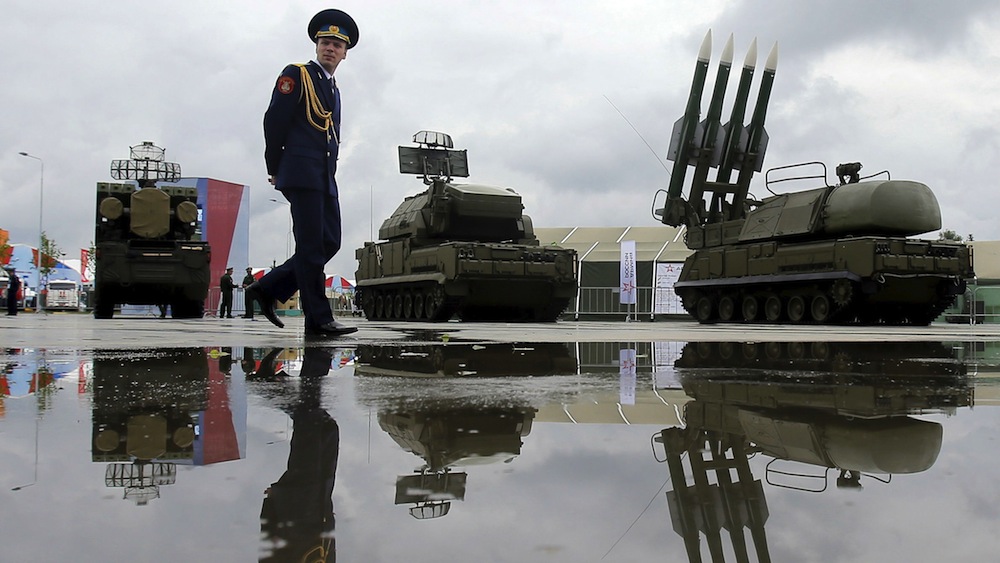Don’t fall for Russian President Vladimir Putin’s nuclear grandstanding: economically, he has his back to the wall. The deployment of US troops and heavy weapons in Eastern Europe would only play into his hands.
Last week there were two pieces of news from Russia, which at first may not seem connected: Putin announced the addition of more than 40 new intercontinental ballistic missiles to the country’s arsenal, and Russian industrial production declined 2.3 percent for the first five months of the year (with a 5.5 percent decline in May alone). President Vladimir Putin’s announcement – delivered in the newly opened Patriot Park, something of a Russian “military Disneyland” – was widely interpreted as a reaction to American talk of deploying 5,000 US soldiers to and pre-positioning heavy ordinance in Eastern Europe. However, it should really be seen in connection with Russia’s resounding economic crisis. Without any prospect for an improvement of the political climate and with an economic crisis that has continued nearly unabated since 2008-09, Russia’s downward spiral is only just beginning.
Putin is opting for a mobilization of Russian society in order to distract from his failed economic policy. This is nothing new, as the “Pussy Riot” case of 2012 showed: an example was made of Russian punk rockers during a period of slipping approval numbers, displaying the consequences of “decadent” Western influence before the eyes of the populace and allowing Putin to play the defender of traditional values. In the same vein, the Kremlin is using the expansion of the army, particularly Russia’s symbolic “Great Power” nuclear forces, to orchestrate conflicts with the West. However, the intended target is not the West but rather Russia’s own people, who must hold someone accountable for their country’s failed economic policy or find a culprit – even a new enemy.
In this narrative, the EU, with its recently extended sanction policy, is to blame for this crisis. The US is another enemy, playing its little game in Ukraine and now planning to station troops and heavy weapons in Eastern Europe. Moscow’s answer was almost to be expected: in addition to the nuclear arms build-up, Putin announced the creation of two more radar nodes in both the West and the East of the country. The defense ministry also wants new Iskander rockets – compatible with atomic warheads – stationed in the Kaliningrad Oblast near the EU border.
While the Russian economic crisis of 2008-09 was primarily caused by external factors amenable to massive state intervention, the continuing deterioration of Russia’s economy is due to structural deficits; it is a deterioration that is merely reinforced by outside factors such as oil price drops and sanctions, coming at a time when the Russian state lacks the funds for another massive intervention. The state is already spending to cover its enormous public expenses, particularly the salaries of loyal civil servants and the cost of modernizing the army – and despite its outlays, Russia is only in third place in terms of military expenditure, behind the United States and China.
In contrast to his first two terms of office between 2000 and 2008, Putin must now govern a country in economic decline, one that is questioning the legitimacy of his system. This has led straight to the Ukraine crisis and the present confrontation with the West. Should the United States actually arm its Eastern European partners, Moscow would have Washington where it wanted it since the beginning of the crisis: as an antagonist on equal terms attempting to use Ukraine to limit Russia’s influence in the post-Soviet sphere.
US President Barack Obama and NATO would be doing Putin a great favor, reinforcing Russian propaganda that “it’s all the Yankees’ fault.” In reality, Russia’s leadership has no interest in attacking NATO members, but it is now trapped in a mobilization spiral, and the West playing along will only make this situation more dangerous.
NATO’s decision to strengthen its preparedness by forming a spearhead to its rapid reaction force, a step announced at the September 2014 Wales summit, was the right move to reassure its eastern European partners. On the other hand, sending troops and heavy weapons to these countries now could spur new Russian arming and greatly exacerbate a situation that is not, in fact, as explosive as it seems. Economically, Putin finds himself with his back to the wall; even if sanctions were dropped tomorrow, without Western investment and structural reform he cannot escape the corner he painted himself into. This should make Washington and the Eastern Europeans think twice: deterrence, yes; provocation, no.







